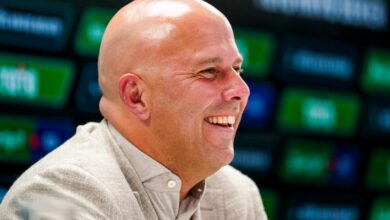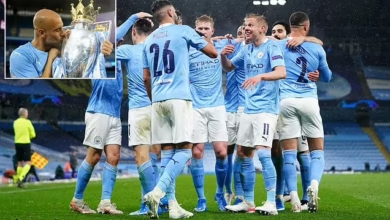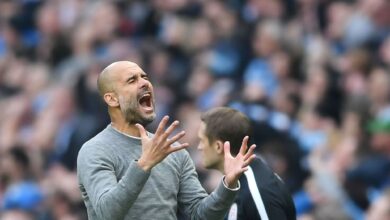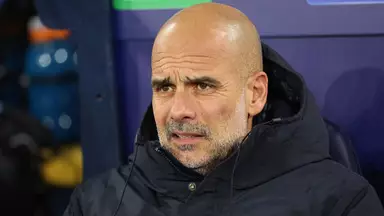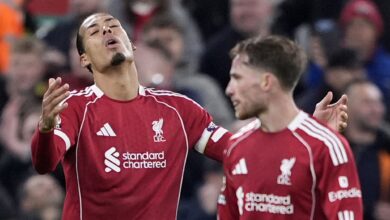Man City manager Pep Guardiola has submitted £90m+ bid to sign “exceptional” Bundesliga star

Manchester City stands at a pivotal crossroads in their illustrious recent history. The club that has dominated English football for over a decade now faces one of their most significant transitional periods, as the departure of Kevin De Bruyne looms large over the Etihad Stadium. The Belgian maestro, whose contract expires at the season’s end, has been the orchestrator of City’s golden era, but time waits for no one in the relentless world of modern football.
In response to this impending departure, Manchester City has made a statement of intent that reverberates throughout European football. The club has reportedly submitted a staggering £92.5 million bid for a player widely believed to be Dutch sensation Xavi Simons, currently plying his trade at RB Leipzig on loan from Paris Saint-Germain. This astronomical figure represents more than just a transfer fee; it embodies City’s unwavering commitment to maintaining their position at the pinnacle of world football.
The timing of this bid is particularly significant. Rather than waiting for De Bruyne’s departure to become a reality, Manchester City has adopted a proactive approach that demonstrates the sophisticated planning that has become synonymous with their operations under the current ownership. This forward-thinking strategy ensures that the club will not experience the transitional struggles that have befallen other major clubs when losing their talismanic figures.
The De Bruyne Legacy: A Decade of Excellence
To understand the magnitude of replacing Kevin De Bruyne, one must first appreciate the extraordinary impact he has had during his tenure at Manchester City. Since his arrival from VfL Wolfsburg in 2015, De Bruyne has redefined what it means to be a modern midfielder. His statistical output tells only part of the story: over 100 assists in all competitions, countless match-winning performances, and a consistency that has been the bedrock of City’s success.
De Bruyne’s influence extends far beyond mere numbers. His vision has unlocked defenses that appeared impenetrable, his passing range has created opportunities from seemingly impossible positions, and his leadership has guided teammates through the most pressure-filled moments. The Belgian has been instrumental in City’s four Premier League titles, their Champions League triumph, and numerous domestic cup victories.
At 33, De Bruyne represents the old guard of Manchester City’s transformation under Pep Guardiola. His partnership with the Spanish manager has produced some of the most scintillating football witnessed in the modern era. The understanding between player and coach has been telepathic, with De Bruyne often serving as the on-field extension of Guardiola’s tactical vision.
However, the harsh reality of professional football is that even the greatest players must eventually pass the torch. De Bruyne’s physical demands have taken their toll, and while he remains an exceptional player, the club must plan for a future without their creative cornerstone. This planning has led them to identify and pursue what they believe to be the perfect successor.
The Saudi Arabian Temptation and American Ambitions
The speculation surrounding De Bruyne’s next destination has intensified as his contract situation remains unresolved. Saudi Arabia’s Public Investment Fund-backed league has emerged as a significant player in the global transfer market, offering astronomical wages that can tempt even the most established stars to consider a move to the Middle East.
The Saudi Pro League’s aggressive recruitment strategy has already lured several high-profile players, including Cristiano Ronaldo, Neymar, and Karim Benzema. For De Bruyne, the financial incentives are undoubtedly attractive, particularly as he enters the twilight of his career. The opportunity to secure generational wealth while still performing at the highest level presents a compelling proposition.
Simultaneously, Major League Soccer’s newest franchise, San Diego FC, has emerged as another potential destination. The club’s sporting director, Tyler Heaps, has been transparent about their interest in the Belgian international, viewing him as a marquee signing that could elevate both the club and the league’s profile. However, Heaps has also acknowledged the financial challenges associated with meeting De Bruyne’s current wage demands of £400,000 per week.
The American market represents a different kind of opportunity for De Bruyne. While the financial package may not match Saudi Arabian offers, MLS provides a platform for continued high-level competition while potentially opening doors to post-playing career opportunities in one of the world’s largest sports markets. The league’s designated player rule allows clubs to pay above the salary cap for exceptional talents, but even this flexibility has its limits when dealing with Premier League-level wages.
Xavi Simons: The Chosen Successor
Manchester City’s identification of Xavi Simons as De Bruyne’s potential replacement represents a masterclass in talent identification and strategic planning. The 22-year-old Dutch international has emerged as one of Europe’s most promising midfielders, combining technical brilliance with the tactical intelligence that Guardiola values so highly in his players.
Simons’ journey to prominence has been anything but conventional. After progressing through Barcelona’s famed La Masia academy, he made the bold decision to join Paris Saint-Germain’s youth setup, seeking greater opportunities for development. His time in Paris showcased his exceptional technical ability, but it was his loan move to PSV Eindhoven that truly announced his arrival on the European stage.
During his time in the Eredivisie, Simons demonstrated the kind of creative flair and tactical awareness that immediately caught the attention of Europe’s elite clubs. His ability to operate in multiple positions across the midfield and attack makes him an ideal fit for Guardiola’s fluid system, where positional interchange and tactical flexibility are paramount.
The subsequent loan move to RB Leipzig has provided Simons with Bundesliga experience, widely regarded as one of the most competitive and tactically sophisticated leagues in world football. Under the guidance of Leipzig’s coaching staff, he has continued to develop his understanding of the game while adapting to the physical and mental demands of top-level football.
What makes Simons particularly attractive to Manchester City is his profile as a player who can grow into the role rather than simply fill it. While De Bruyne’s departure will create an immediate void, Simons represents a long-term investment in the club’s future. His age profile aligns perfectly with City’s strategy of building a squad capable of sustaining success over multiple seasons.
Guardiola’s Vision and Tactical Considerations
Pep Guardiola’s admiration for Simons is rooted in more than just the player’s technical ability. The Spanish manager has built his reputation on identifying players who can execute his complex tactical systems while maintaining the creativity and unpredictability that elite football demands. In Simons, Guardiola sees a player who possesses the rare combination of tactical discipline and creative freedom that defines his most successful signings.
The integration of Simons into City’s system would likely follow a similar pattern to other young talents who have thrived under Guardiola’s guidance. The manager’s ability to accelerate player development through intensive coaching and tactical education has been evident in the careers of players like Phil Foden, who has evolved from a promising academy graduate to an international star under Guardiola’s tutelage.
Simons’ versatility would provide Guardiola with tactical options that could prove invaluable in different match situations. His ability to play as a traditional number 10, a false nine, or even in wider positions would allow City to maintain their tactical fluidity while providing different approaches to breaking down stubborn defenses.
The transition from De Bruyne to Simons would not necessarily require a complete overhaul of City’s tactical approach. Both players possess the vision and passing ability to serve as the creative hub of the team, though their styles differ in subtle but important ways. While De Bruyne’s experience and leadership have been crucial to City’s success, Simons brings a different kind of energy and unpredictability that could inject new life into the team’s attacking play.
The Financial Landscape and Market Dynamics
The £92.5 million bid for Simons must be viewed within the context of the current transfer market, where exceptional young talent commands premium fees. Manchester City’s willingness to invest such a substantial sum demonstrates their recognition that securing the right player at the right time often requires bold financial commitments.
This investment strategy reflects the club’s understanding that the cost of acquiring top talent continues to escalate, making early identification and decisive action essential. By moving for Simons now, rather than waiting for his stock to rise further, City may actually be securing a bargain in the context of future market inflation.
The financial structure of modern football also influences such decisions. With Financial Fair Play regulations requiring clubs to balance their books, Manchester City’s strong revenue streams and commercial partnerships provide the foundation for such significant investments. The club’s global brand and commercial success enable them to compete with any club in the world when it comes to transfer fees and wages.
Furthermore, the potential departure of De Bruyne would free up a significant portion of the club’s wage bill, creating space for new investments. This natural turnover in the squad allows City to refresh their team while maintaining financial compliance with regulatory requirements.
Competition and Complications
Manchester City’s pursuit of Simons is complicated by the player’s current situation at Paris Saint-Germain. While he is on loan at RB Leipzig, PSG retains his registration and will ultimately decide his future. This adds a layer of complexity to any potential transfer, as City must not only convince the player but also negotiate with multiple parties.
PSG’s own strategic considerations will play a crucial role in determining Simons’ future. The French giants have invested heavily in the player’s development and may be reluctant to sell to a direct competitor in European competition. However, the substantial transfer fee being offered by City could prove too attractive to refuse, particularly if PSG has identified alternative targets for their own squad development.
RB Leipzig’s position in these negotiations is also significant. The German club has benefited from Simons’ contributions during his loan spell and may attempt to secure a permanent transfer themselves. However, their financial resources are likely insufficient to compete with Manchester City’s offer, potentially making them a facilitator rather than a competitor in the process.
The player’s own preferences will ultimately be decisive. Simons must weigh the immediate opportunity to join one of the world’s most successful clubs against other potential career paths. The chance to work under Guardiola and compete for the highest honors in world football presents a compelling proposition for any young player with ambitions of reaching the very top of the game.
The Broader Strategic Context
Manchester City’s aggressive pursuit of Simons represents more than just a single transfer; it embodies the club’s broader strategic approach to squad building and competitive sustainability. The club has consistently demonstrated a willingness to invest in young talent while maintaining a core of experienced players, creating a balanced squad capable of competing across multiple competitions.
This strategy has proven successful in recent years, with the club’s academy graduates and young signings contributing significantly to their success. Players like Foden, Joao Cancelo, and Erling Haaland have all benefited from the club’s development programs and tactical education, suggesting that Simons would enter an environment optimized for his continued growth.
The timing of this potential transfer also aligns with the club’s natural squad evolution. Several key players are entering the later stages of their careers, creating opportunities for younger talents to assume greater responsibilities. This generational transition, if managed effectively, could extend City’s period of dominance rather than creating a disruptive changing of the guard.
International Implications and Career Development
For Simons, a move to Manchester City would represent a significant step in his international career development. The Dutch national team has undergone its own transition in recent years, with a new generation of talented players emerging to replace the previous golden generation. Simons’ development at a club like City could accelerate his progression within the national team setup.
The exposure to Champions League football and the highest levels of domestic competition would provide Simons with experiences that are crucial for international success. Manchester City’s consistent participation in the latter stages of major competitions would give him the platform to develop the mentality and skills necessary for success at the highest level.
Moreover, working alongside established international stars within City’s squad would provide invaluable learning opportunities. The club’s multinational roster includes players who have excelled at World Cups and European Championships, offering Simons access to a wealth of experience and knowledge.
The Technical Integration Challenge
The successful integration of Simons into Manchester City’s system would require careful management of his development and adaptation to the Premier League’s unique demands. The English top flight presents challenges that are different from those found in other major European leagues, including increased physicality, pace, and tactical variation between opponents.
Guardiola’s track record with young players suggests that this integration process would be carefully managed. The Spanish manager has consistently shown patience with talented youngsters, providing them with opportunities to develop while protecting them from excessive pressure or unrealistic expectations.
The club’s extensive support infrastructure, including sports science, psychology, and tactical analysis departments, would be instrumental in helping Simons adapt to his new environment. Manchester City’s investment in these areas has been a key factor in their ability to integrate new signings successfully and maximize their potential.
Looking Toward the Future
As Manchester City awaits a response to their ambitious bid, the football world watches with interest to see how this potential transfer saga unfolds. The successful acquisition of Simons would represent a significant statement of intent from the club, demonstrating their commitment to maintaining their competitive edge in an increasingly challenging football landscape.
The implications of this potential transfer extend beyond immediate tactical considerations. It would signal the beginning of a new era at the Etihad Stadium, one that honors the legacy of players like De Bruyne while embracing the possibilities that come with new talent and fresh perspectives.
Whether or not this particular transfer materializes, Manchester City’s proactive approach to squad planning sets a standard for how elite clubs must operate in the modern game. The willingness to invest heavily in potential rather than just proven performance reflects a sophisticated understanding of player development and market dynamics.
The coming weeks and months will reveal whether this bold gamble pays off, but one thing is certain: Manchester City’s pursuit of excellence continues unabated, and their vision for the future remains as ambitious as ever. In a sport where standing still means falling behind, their aggressive pursuit of the next generation of talent ensures they remain at the forefront of football’s evolution.






